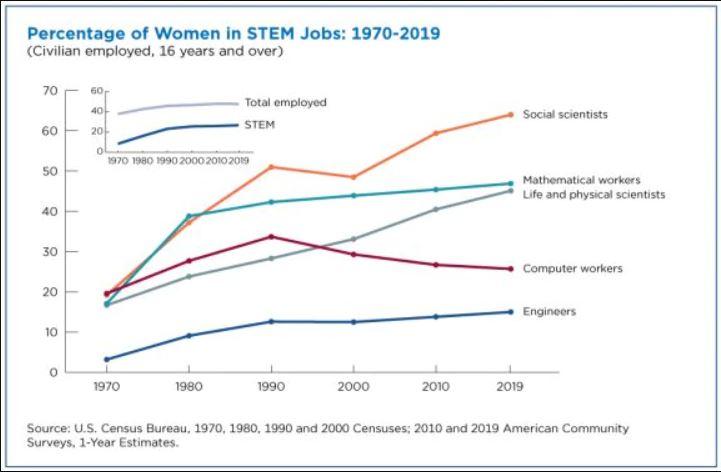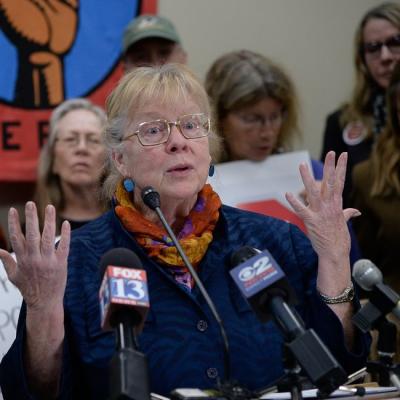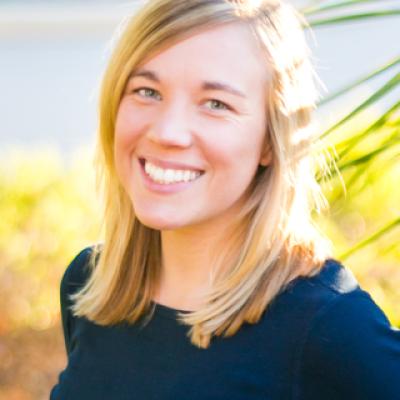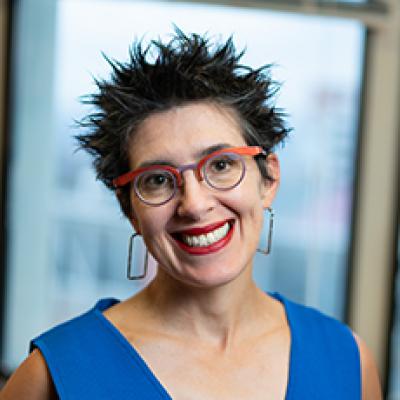Representation
The last 50 years, we have seen a rise in women in the workforce, with a drasict rise in the STEM fields.
“In 1970, women made up 38% of all U.S. workers and 8% of STEM workers. By 2019, the STEM proportion had increased to 27% and women made up 48% of all workers” (Census Data)
While this change has been profound, there is a lot of work required to create equal representation for women in all fields, especially in STEM. Many women in the STEM fields are trailblazers due to lack of representation.
"When I was growing up, scientists all looked like white males...I didn't have any [women] science teachers in high school; maybe one biology professor in college who was female. Um, but no chemistry professor that's for sure...all through my education, science was conducted by white males, which, you know, that's just the way it was...now though, I think that it's pretty fun that scientists can look like just about anything."
Specific Fields
Kirtly Parker Jones, MD is an advocate for the gender representation among medical students. She originally began her residency program at Brigham, the number of women in pediatrics and OB/GYN wereon the rise. However there was still a sense that women were the minority in medicine.
"I'd like to see more women in medicine, and right now, I think the U [University of Utah] is about 50/50 in terms of medical students. And in some parts of the country, there are more women in medical school than men. But I’d like to see 50/50 and I’d like to see them equally distributed around the specialties"
"[In grad school], my whole cohort was females... There were very few males in the psychology program, and the professors were fairly evenly split, but the students were predominantly women. Psychology is considered more welcoming to women compared to other sciences... There are a lot more women in the field, which makes it easier to find people who understand what you're going through. But there are still challenges in terms of balancing work, recognition, and family responsibilities."
Trailblazing Women in STEM
McKenzie Skiles, PhD, an environmental scientist specializing in snow hydrology, speaks on her experiences of not having representation in her field.
"I always kind of felt like I was forging my own path and that I didn't really have many women— especially in the field that I'm in now, snow science—to look up to or interact with. When I got farther into graduate school I kind of sought people out, and I did end up finding people, but when I was still figuring out what I wanted to do and going into graduate school, there weren’t many women, or many women that I was aware of."
"So I think it's less so now, but very early on it is usually about 75 to 80% women in vet school classes. And then slowly as you specialize, there are more and more men and less and less women. Usually once you get into faculty positions, there are way more men in those roles than there are women. It's becoming, I think, less so now. There are more women who are specializing now."
Why Representation is Important
Finally, Lisa Diamond, PhD, speaks on the importance of representation and shares her experience of being out and proud as a lesbian in psychology research. In particular, she shares that students seemingly expected her to be a lesbian due to her gender studies research, but, from the responses she received from the students, sharing her identity had an impact.
"I think visibility is just a huge thing. And, I think, being in Utah has made me very aware of it. From the beginning of my teaching at Utah, even when I didn't explicitly come out to my students, given the kind of work that I do, I was kind of known for doing research on queer topics, people just assumed I was a lesbian anyway. So students would email me and be like, “you are the first lesbian that I saw in person,” and I was like, “happy to help.” But you know growing up in big cities like Los Angeles, and then going to school in Chicago, I was always aware that gay people existed, it was just easier to see them around. When, for some of my students who grew up in Salt Lake City or who are raised in the Mormon church, they don’t see a lot of that. And I’ve realized how powerful it can be just to be out and visible and to just kind of be your total queer self. And so, if anything, over the years, I've tried to be as out and visible as I can in Utah. I do a lot of work with community organizations. I do some trainings for the Veterans Administration on sexuality and gender issues, for the Department of Pediatrics at the hospital, for therapists guilds. I've tried to do everything that I could to raise the visibility about these issues and to make them more normal, here in this little weird pocket of the world."
Page written and researched by Sophie Jensen, with sections from the original page by Jacqueline Cockrell, Shaistah Din, Cullen O'Brien, and Jack Temme.
Later edited by Pamalatera C. Fenn






